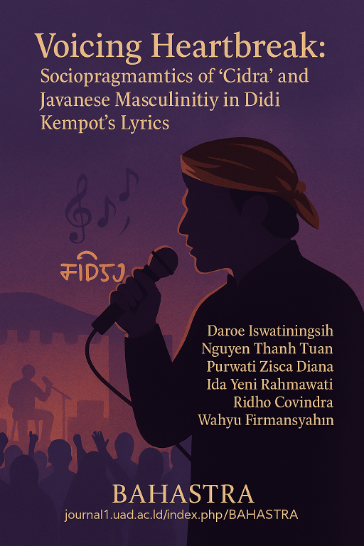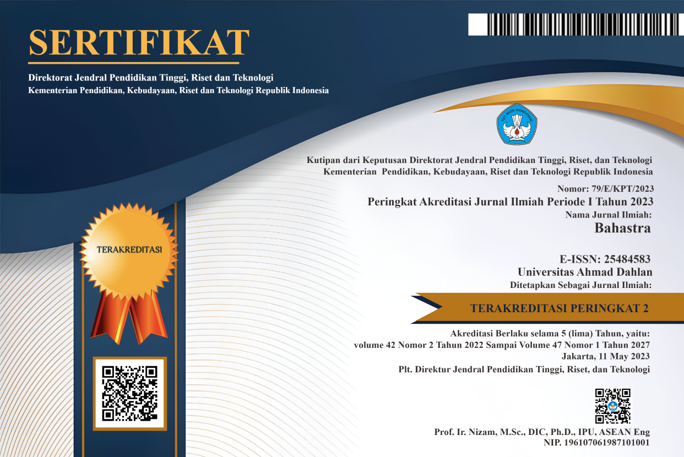Voicing heartbreak: The sociopragmatics of ‘Cidra’ and Javanese masculinity in Didi Kempot’s lyrics
DOI:
https://doi.org/10.26555/bs.v45i2.1604Keywords:
Didi Kempot, Javanese , Masculinity, Popular Music , SociopragmaticsAbstract
This study investigates the representation of cidra (heartbreak or betrayal of promise) and the construction of Javanese masculinity in Didi Kempot’s song lyrics through a sociopragmatic approach. Drawing on seven songs from four albums, the analysis proceeds in three steps: (1) segmenting the lyrics into expressive speech acts, (2) interpreting them through affective cultural scripts, and (3) situating the findings within masculinity discourses. The results reveal a tripartite model of male emotionality: (1) loyalty and patience that affirm Javanese cultural values, (2) emotional fragility expressed through crying and complaint, which challenges the script of stoic masculinity, and (3) resignation (lilo) as a culturally sanctioned coping mechanism. These dimensions converge into the concept of hybrid masculinity, which reconciles normative ideals with emotional expressions previously deemed inappropriate for Javanese men. Theoretically, this study contributes a sociopragmatic framework for analyzing emotional speech acts in non-Western contexts and positions popular music not only as a reflection but also as a site for reshaping gender norms. Practically, it demonstrates how Didi Kempot’s songs function as a form of collective cultural therapy, offering insights for culturally sensitive approaches to men’s mental health.
References
Agyekum, K. (2021). Proverbs in Akan highlife lyrics: A case study of Alex Konadu’s lyrics. Journal of Pragmatics, 174, 1–13. https://doi.org/10.1016/j.pragma.2020.12.016
Al-Hamzi, A. M. S., Nababan, M., Santosa, R., & Anis, M. Y. (2024). Sociopragmatic analysis of utterances with polite addressing terms: Translation shift across Arabic-English cultures. Cogent Arts & Humanities, 11(1), 2359764. https://doi.org/10.1080/23311983.2024.2359764
Awan, S., Yahya, U., & Arif, M. (2023). Quality standards of qualitative research in applied linguistics: A conceptual review. VFAST Transactions on Education and Social Sciences, 11(2), 68–75. https://doi.org/10.21015/vtess.v11i2.1528
Baxter, A. (2019). “Clever” tools and social technologies: To what extent does wider access to technology necessitate a step change in approaches to teaching music production? In Producing Music. Routledge. https://doi.org/10.4324/9781315212241-17
Bennett, A., & Janssen, S. (2016). Popular music, cultural memory, and heritage. Popular Music and Society, 39(1), 1–7. https://doi.org/10.1080/03007766.2015.1061332
Berke, D. S., Reidy, D., & Zeichner, A. (2018). Masculinity, emotion regulation, and psychopathology: A critical review and integrated model. Clinical Psychology Review, 66, 106–116. https://doi.org/10.1016/j.cpr.2018.01.004
Biria, R., & Mohammadi, A. (2012). The socio pragmatic functions of inaugural speech: A critical discourse analysis approach. Journal of Pragmatics, 44(10), 1290–1302. https://doi.org/10.1016/j.pragma.2012.05.013
Calogero, R. M. (2013). Objects don’t object: Evidence that self-objectification disrupts women’s social activism. Psychological Science, 24(3), 312–318. https://doi.org/10.1177/0956797612452574
Charron, J.-P. (2017). Music audiences 3.0: Concert-Goers’ psychological motivations at the dawn of virtual reality. Frontiers in Psychology, 8:800. https://doi.org/10.3389/fpsyg.2017.00800
Chen, Y., & Buckingham, L. (2025). Introduction to go-alongs as a qualitative research method in applied linguistics. Research Methods in Applied Linguistics, 4(2), 100196. https://doi.org/10.1016/j.rmal.2025.100196
Cheng, W., & Lam, P. (2020). Speech acts, facework, and politeness: Sociopragmatics and intercultural relationship-building. Routledge. https://doi.org/10.4324/9781003036210-12
Chentsova-Dutton, Y., & Maercker, A. (2019). Cultural scripts of traumatic stress: Outline, illustrations, and research opportunities. Frontiers in Psychology, 10, 2528. https://doi.org/10.3389/fpsyg.2019.02528
Cleary, A. (2012). Suicidal action, emotional expression, and the performance of masculinities. Social Science & Medicine, 74(4), 498–505. https://doi.org/10.1016/j.socscimed.2011.08.002
Cohen, S. (2013). Musical memory, heritage and local identity: Remembering the popular music past in a European Capital of Culture. International Journal of Cultural Policy, 19(5), 576–594. https://doi.org/10.1080/10286632.2012.676641
Connell, R. W. (1990). The state, gender, and sexual politics: Theory and appraisal. Theory and Society, 19(5), 507–544. https://doi.org/10.1007/BF00147025
___________. (1992). A very straight gay: Masculinity, homosexual experience, and the dynamics of gender. American Sociological Review, 57(6), 735–751. https://doi.org/10.2307/2096120
___________. (1993). The big picture: Masculinities in recent world history. Theory and Society, 22(5), 597–623. https://doi.org/10.1007/BF00993538
___________. (2003). Masculinities, change, and conflict in global society: Thinking about the future of men’s studies. The Journal of Men’s Studies, 11(3), 249–266. https://doi.org/10.3149/jms.1103.249
___________. (2005). Growing up masculine: Rethinking the significance of adolescence in the making of masculinities. Irish Journal of Sociology, 14(2), 11–28. https://doi.org/10.1177/079160350501400202
___________. (2008). On hegemonic masculinity and violence: Response to Jefferson and Hall. Routledge.
Connell, R. W., & Messerschmidt, J. W. (2005). Hegemonic masculinity: Rethinking the concept. Gender & Society, 19(6), 829–859. https://doi.org/10.1177/0891243205278639
Cooper, N. I. (2015). Retuning javanese identities: The ironies of a popular genre. Asian Music, 46(2), 55–88. https://doi.org/10.1353/amu.2015.0016
Demetriou, D. Z. (2001). Connell’s concept of hegemonic masculinity: A critique. Theory and Society, 30(3), 337–361. https://doi.org/10.1023/A:1017596718715
Emslie, C., Ridge, D., Ziebland, S., & Hunt, K. (2006). Men’s accounts of depression: Reconstructing or resisting hegemonic masculinity? Social Science & Medicine, 62(9), 2246–2257. https://doi.org/10.1016/j.socscimed.2005.10.017
Farese, G. M. (2022). The ethnopragmatics of English stage-of-life words as forms of address. Australian Journal of Linguistics, 42(1), 1–23. https://doi.org/10.1080/07268602.2022.2043824
Gee, J. P. (2014). Literacy and education. Routledge. https://doi.org/10.4324/9781315739571
Gibson, K. (2009). Music, melancholy, and masculinity in early modern England 1. Routledge.
Goddard, C., & Wierzbicka, A. (2014). Semantic fieldwork and lexical universals. Studies in Language. International Journal Sponsored by the Foundation “Foundations of Language,” 38(1), 80–127. https://doi.org/10.1075/sl.38.1.03god
Hadi, S., & Sunarto, S. (2025). The complexity of genre and discourse in Indonesian popular music: A systematic literature review. Rast Musicology Journal, 13(2), 105-126. https://doi.org/10.12975/rastmd.20251321
Hasada, R. (2011). 6. Cultural scripts: Glimpses into the Japanese emotion world. In C. Goddard (Ed.), Ethnopragmatics: Understanding Discourse in Cultural Context. De Gruyter Mouton. https://www.degruyterbrill.com/document/doi/10.1515/9783110911114.171/pdf?licenseType=restricted
Hasan, E. B. G., Binarum, F. R., Kengtyas, G. P., & Ananda, D. A. V. (2025). Hegemoni laki-laki di balik keikutsertaan mengerjakan kerja domestik dalam iklan motionlife 2024. Jurnal Audiens, 6(2), 321–331. https://doi.org/10.18196/jas.v6i2.575
Heriyanto & Firmansyah. (2020). Transposisi TTI (transfer, translation, imitate) dalam pembelajaran notasi musik melalui score creator. Jurnal Sitakara, 5(2), 77-85. https://doi.org/10.31851/sitakara.v5i2.4782
Heidari, A., Heidari Tabrizi, H., & Chalak, A. (2020). Using short stories vs. video clips to improve upper intermediate EFL students’ sociopragmatic knowledge: Speech acts in focus. Cogent Arts & Humanities, 7(1), 1778977. https://doi.org/10.1080/23311983.2020.1778977
Hodges Jr., D. G. (2024). Country music: The most diverse genre? Journal of the Music and Entertainment Industry Educators Association, 24(1), 14–21. https://doi.org/10.2478/meiea-2024-0003
Ishii, K., & Eisen, C. (2021). Chapter 30—measuring and understanding emotions in East Asia. In H. L. Meiselman (Ed.), Emotion Measurement (Second Edition). Woodhead Publishing. https://doi.org/10.1016/B978-0-12-821124-3.00030-2
Jansz, J. (2000). Masculine identity and restrictive emotionality. In A. H. Fischer (Ed.), Gender and Emotion: Social Psychological Perspectives. Cambridge University Press. https://doi.org/10.1017/CBO9780511628191.009
Jay, M. (2007). Melancholy femininity and obsessive—compulsive masculinity: Sex Differences in melancholy gender. Studies in Gender and Sexuality, 8(2), 115–135. https://doi.org/10.1080/15240650701225435
Jewkes, R., Morrell, R., Hearn, J., Lundqvist, E., Blackbeard, D., Lindegger, G., Quayle, M., Sikweyiya, Y., & Gottzén, L. (2015). Hegemonic masculinity: Combining theory and practice in gender interventions. Culture, Health & Sexuality, 17, 112–127. https://doi.org/10.1080/13691058.2015.1085094
Kulczynski, A., Baxter, S., & Young, T. (2016). Measuring motivations for popular music concert attendance. Event Management, 20(2), 239–254. https://doi.org/10.3727/152599516X14643674421816
Kusumawati, H. S., Rahayu, N. T., & Fitriana, D. (2019). Analisis semiotika model Roland Barthes pada makna lagu “Rembulan” karya Ipha Hadi Sasono. KLITIKA Jurnal Ilmiah Pendidikan Bahasa dan Sastra Indonesia, 1(2), 105-116. https://doi.org/10.32585/klitika.v1i2.476
Lowenthal, L. (1990). Historical perspectives on popular culture. In Critical Theory and Society. Routledge.
Mahfud, C., Astari, R., Kasdi, A., Mu'ammar, M. A., Muyasaroh, M., & Wajdi, F (2022). Islamic cultural and Arabic linguistic influence on the languages of Nusantara;From lexical borrowing to localized Islamic lifestyles. Wacana Journal of the Humanities of Indonesia, 22(1) 224-248. https://doi.org/10.17510/wacana.v22i1.914
Masuda, T., Wang, H., Ishii, K., & Ito, K. (2012). Do surrounding figures’ emotions affect judgment of the target figure’s emotion? Comparing the eye-movement patterns of European Canadians, Asian Canadians, Asian international students, and Japanese. Frontiers in Integrative Neuroscience, 6 (72). https://doi.org/10.3389/fnint.2012.00072
Mohammed-baksh, S., & Callison, C. (2015). Hegemonic Masculinity in hip-hop music? Difference in brand mention in rap music based on the rapper’s gender. Journal of Promotion Management, 21(3), 351–370. https://doi.org/10.1080/10496491.2015.1039177
Qorib, F., & Dewi, S. I. (2021). Sobat ambyar: The phenomenon of fans, social media, and modern campursari music in Indonesia. Jurnal_Pekommas, 6(2), 67–76. https://doi.org/10.56873/jpkm.v6i2.3960
Ramadhani, L. C. (2023). Pergeseran makna maskulinitas dalam lirik lagu (Analisis semiotika Roland Barthes pada lagu “Cidro” oleh Didi Kempot). Commercium, 7(1), 24–31. https://ejournal.unesa.ac.id/index.php/Commercium/article/view/54433/43272
Richter, M. M. (2008). Musical sexualisation and the gendered habitus in Yogyakarta. Indonesia and the Malay World, 36(104), 21–45. https://doi.org/10.1080/13639810802016273
Roulston, K. (2018). Interviews in qualitative research. The Encyclopedia of Applied Linguistics. John Wiley & Sons, Ltd. https://doi.org/10.1002/9781405198431.wbeal0572.pub2
Samar, R. G., Talebzadeh, H., Kiany, G. R., & Akbari, R. (2014). Moves and steps to sell a paper: A cross-cultural genre analysis of applied linguistics conference abstracts. Text & Talk, 34(6), 759–785. https://doi.org/10.1515/text-2014-0023
Searle, J. R. (1976). A classification of illocutionary acts. Language in Society, 5(1), 1–23. https://doi.org/10.1017/S0047404500006837
___________. (1991). Epilogue to the taxonomy of illocutionary acts. Routledge.
Setiawan, R., Nurbani, A. N., Nurhidayah, S., Asryan, A., & Nordin, R. (2023). A postcolonial autopsy on Javanese identity through Campursari lyrics. NOTION: Journal of Linguistics, Literature, and Culture, 5(2), 179-189. https://doi.org/10.12928/notion.v5i2.8161
Stöter, F.-R., Chakrabarty, S., Edler, B., & Habets, E. A. P. (2019). CountNet: Estimating the number of concurrent speakers using supervised learning. IEEE/ACM Transactions on Audio, Speech, and Language Processing, 27(2), 268–282. https://doi.org/10.1109/TASLP.2018.2877892
Sumpter, K. C. (2015). Masculinity and meat consumption: An analysis through the theoretical lens of hegemonic masculinity and alternative masculinity theories. Sociology Compass, 9(2), 104–114. https://doi.org/10.1111/soc4.12241
Tajima, Y., & Yoshinaga, M. (2024). Causal order complex and magnitude homotopy type of metric spaces. International Mathematics Research Notices, 2024(4), 3176–3222. https://doi.org/10.1093/imrn/rnad124
Terkourafi, M., Catedral, L., Haider, I., Karimzad, F., Melgares, J., Mostacero-Pinilla, C., Nelson, J., & Weissman, B. (2018). Uncivil twitter: A sociopragmatic analysis. Journal of Language Aggression and Conflict, 6(1), 26–57. https://doi.org/10.1075/jlac.00002.ter
Ulya, C., Sari, R. D. P., Saddhono, K., & Sudaryanto, M. (2021). Representation of Javanese masculinity in the dangdut songs lyric. Masculinities & Social Change, 10(2), 139-161. https://doi.org/10.17583/mcs.2021.5967
van Dijk, L., & Rietveld, E. (2021). Situated talking. Language Sciences, 87, 101389. https://doi.org/10.1016/j.langsci.2021.101389
Widyawati, N., & Santoso, W. M. (2020). Didi Kempot: Masculinity and actor in circulation and consumption in industrial revolution 4.0. 186–189. https://doi.org/10.2991/assehr.k.200818.043
Wierzbicka, A. (2011). “Cultural scripts”: A new approach to the study of cross-cultural communication. John Benjamins Publishing Company. https://www.degruyterbrill.com/document/doi/10.1075/z.71.04wei/html
Wierzbicka, A. (2014). Language and cultural scripts. Routledge.
Zhang, M., Wang, Y., & Hou, L. (2024). Gender norms and the child penalty in China. Journal of Economic Behavior & Organization, 221, 277–291. https://doi.org/10.1016/j.jebo.2024.03.011.

Downloads
Published
Issue
Section
License
Copyright (c) 2025 Daroe Iswatinginsih, Nguyen Thanh Tuan, Purwati Zisca Diana, Ida Yeni Rahmawati, Ridho Covinda Wahyu Firmansyah

This work is licensed under a Creative Commons Attribution-ShareAlike 4.0 International License.

1.jpg)






